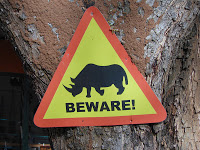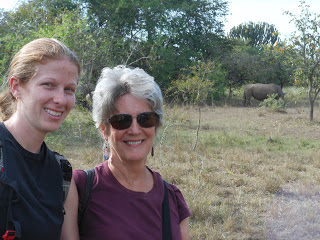
Yes – Obama! Yesterday we went Rhino Trekking at the Aiwa Rhino Sanctuary about two and a half hours south of Gulu, off the road to Kampala. The road was absolute torture even though we were riding with our friends in their very nice, Toyota SUV. Clearly these were not Peace Corps friends, though they were Peace Corps folks in Siberia, which is why they take mercy on us now (to our great joy and appreciation)! The roads are just that bad and the worst part was the paved section. That just seems wrong. We saw three overturned 18-wheelers on the way and that was just the morning’s yield. They were not there the day before. It’s always sobering. Under one of them was a man taking a nap.

We arrived at about 2:30 – giving the Rhinos time to wake up and read their Sunday paper. Turns out Rhinos are not early risers. They don’t get active until about 4:00 when they start grazing, take a little saunter down to the local watering hole, wallow in the mud a bit then eat all night. So we ate lunch and climbed in the Cow Truck as it’s called to go find the Obama family, consisting of Obama (right), Bella and Donna. I wonder if Michelle knows??? Rhinos, which are endemic to Uganda, became extinct in 1982 due to the war and poaching, to mention two of the main factors. Ziwa was formed in 2005 with the intention of re-introducing Rhinos to their natural habitat. They started with six Rhinos and now have twelve. When they have twenty or so they will relocate some to Murcheson Falls.

Obama is so named because of his heritage: one parent from America, the other from Kenya. So there you are. Baby Donna (left with Mom, Bella) is a one year old weighting about 800 kg. She stays pretty close to her mama and you always see them always within a few feet of each other. Turns out you don’t see Rhino’s in a herd; they tend to graze together as a family. White Rhinos are not a different color from Black Rhinos! Who knew? Well – now you do. There are all manner of theories about why they’re called “white,” including one that assumes it was mistranslated from the Dutch word for “wide.” Another theory has to do with the fact that they like to wallow in a mud and bird-droppings that leaves a whitish caked mud on the skin and the last one has to do with the horn being a lighter color. That’s probably way more than you wanted to know, but when you see one and it’s NOT even remotely whitish – one wonders.

The sanctuary shares its grazing lands with herds of cows (in this case Ankoli) because cows keep the grass short and Rhinos like short grass. About fifty rangers on 12-hour shifts follow the families 24-hours a day, to keep track of them and protect them from poachers, not to mention to know where they are when tourists arrive. When visitors come, they are driven part of the way to which ever families are near and then walk in. We got pretty close considering that these are still wild animals, not tamed or handled by humans in any way. They grazed in front of us in total calm and kept moving in our direction, so we just kept moving back. They have pretty poor eyesight, so we were told along with the advice that if they charge, just climb a tree or hide behind one. Fat chance I’d be remembering that if one get’s me in its cross-hairs.

he beasts below are Ankoli cattle and this picture doesn’t really do them justice! Their horns are between 2 and 3 feet long. And these are not particularly docile creatures. A particularly cantankerous one lifted one of the volunteers off the ground on its horns when she was just walking through the field for training. Evidently they don’t “play well with others,” unless you happen to be another cow or – a Rhino. Wisdom is the greater part of valor, therefore we stand clear. This has at times been a challenge with the herd that occasionally graces the alley leading to my house.
T
